Article by Penny Rafferty // Thursday, Mar. 15, 2018
Sonja Alhäuser’s art practice takes the saying “a feast for the eyes” to a whole new level. She often constructs huge sculptural buffets for her viewers; giant butter-ball cherubs and fountains that overflow with rich red wine fill the gallery. As a viewer, it seems hard not to get carried away with the collective consumption of both the art and the social dynamics that Alhäuser manipulates and constructs through her work. Yet using food in such a heady way also brings up a lot of questions of privilege, time and ethics. Berlin Art Link spoke to Alhäuser about her practice in relation to gender, wealth and the moral coding of using food as a practice.
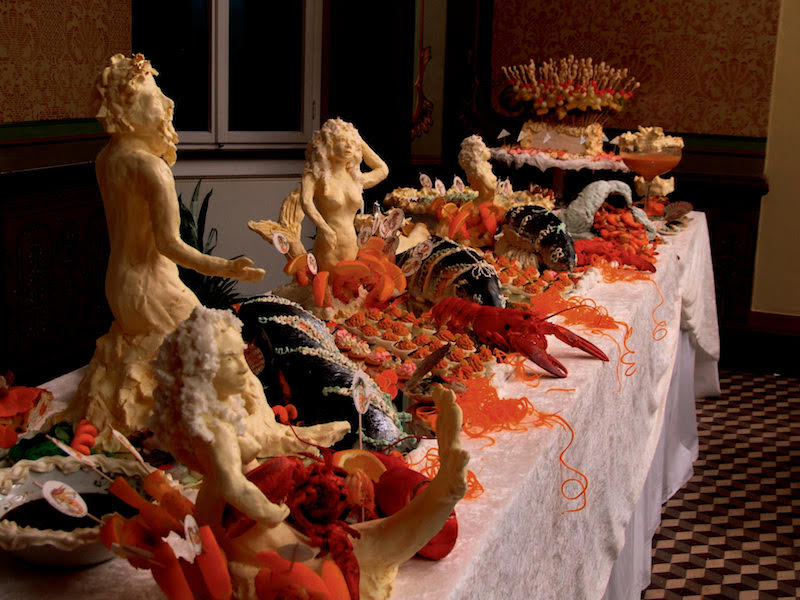
Sonja Alhäuser: ‘Emsrausch’, 2006, performance and installation, butter, seafood, various other foods, security camera, miniature watercolors // Photo by Carsten Gliese, Köln, Courtesy of VG Bild-Kunst, Bonn
Penny Rafferty: Constructs of the female and dinning are often rooted within a cannon of sexual oppression with archetypes like the housewife, the maid and the cook. Yet we have a wide-ranging discourse on such topics in the arts, from Judy Chicago’s epic ‘Dinner Party’ or Caroline Schneemann’s aggressively manipulated organs in ‘Meat Joy’ and Sarah Lucas’s simple but effective bodily manipulations, like ‘two fried eggs and a kebab’. Where did your personal projection towards food and your practice begin?
Sonja Alhäuser: First and foremost the moment I started working with food came from a moment of passion and lust, which can always tilt into the moment of disgust—it is always about a “too much” and/or “too little”. The material itself, in this case food, is often charged with associations that go beyond nutritional value. If I use chocolate in my work, I do not just work with the consistency and shape, the smell and taste of the material, but open up a wide field of thoughts about lust, seduction and loss of control, or about human excrements. Chocolate carries all these notions.
PR: So it’s very complex?
SA: Yes, food is so complex for me that I have been dealing with it for many years. Through food and the consumption of food, I find myself entering into direct contact with the world around me, day by day. Food is an elemental and intimate moment of life, and everyone has to do it. Everyone eats and digests, knows hunger and feelings of fullness, not to mention the sensitivities that have to do with it, unpleasant as well as pleasant. This is the uniting quality of food, in a way.
In my drawings, I follow food through its preparation steps to the end point of eating and on the way through the digestive system. I try to imagine possible transformations or show self-experienced digestive processes. At the same time, the transformation of food (especially in the recipe drawings) has long since acquired some sort of symbolic character as well. Not only do we digest the food, but also its experiences and thus its own world. This goes on for days after the act of consumption.
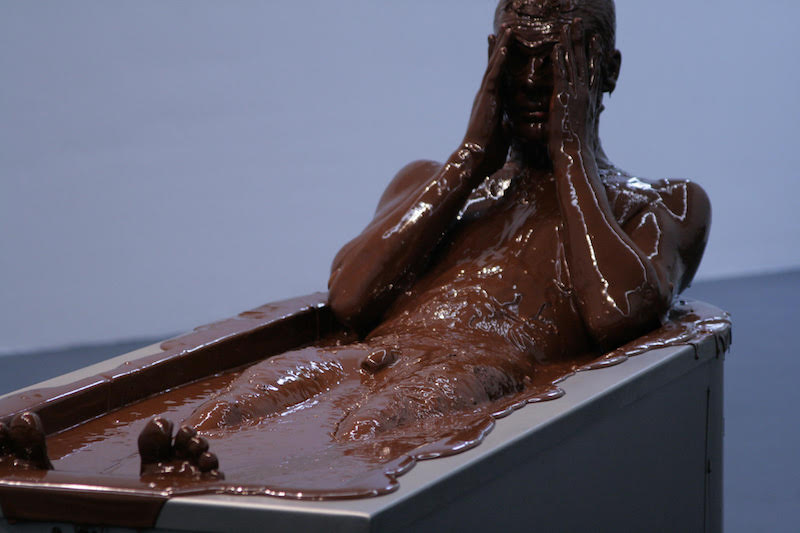
Sonja Alhäuser: ‘Braunes Bad’, 2009–2018, installation and action, stainless steel tray, chocolate, tempering function, tub: 60 x 160 x 80 cm // Courtesy of the Gallery of the University of Fine Arts Braunschweig and VG Bild-Kunst, Bonn, Photo by Michael Lucero
PR: You begin most of your working practice with drawings. These act as recipes and performative plans, yet there is something uniquely naive about this mapping. Was this something that originally stemmed from your childhood?
SA: The self-evident nature of cooking and hospitality comes from my childhood, yes, as was customary in my family. But the drawings have been created as planning since my studies. I began to collect important recipes in this way by recording them. In addition to all the included ingredients, I would make notes of certain handles and tricks that were not taught to me in the usually written recipes. Drawing up a procedure and the working instructions, and thus accumulating all these recipes, gave me security and knowledge, and the ability to convey it to other people. This proves to be very useful for larger banquets because my drawings also serve my team, which I need to carry out major actions. They act as an important guide and pictorial basis for the others.
PR: The banquets are especially unusual in today’s world, where the act of hospitality is so often denied to us in such a hectic world. This isn’t only because of a lack of time but also due to economic implications of hosting, which cost money and inevitably require space, too. How do you see your work in regards to these changing societal structures?
SA: Well, I use my studio regularly to celebrate in, I host feasts and have food. Hospitality is not primarily about expensive dining; for me it’s an act of sharing what you have. The joy of coming together and the common notion of eating and enjoying, I experience time and time again. When we perceive shared pleasure, our joy increases.
In my artistic work, I try to create these communal moments by creating tables that overflow with richness and seduction. I have fountains brimming with red wine. I’m creating a kind of paradise scenario in which all senses are involved: one sees, eats, drinks, tastes, smells, hears, and this is all in a public space.
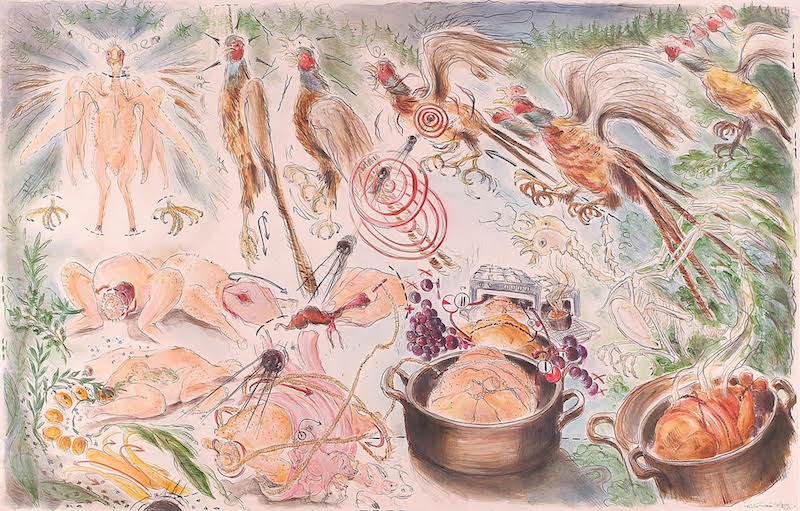
Sonja Alhäuser: ‘Frischer Fasan’, 2010, watercolors, acrylic, crayon, pencil, 90 x 140 cm // Photo by Fabian Georgi, Bremen, Courtesy of Bild-Kunst, Bonn
PR: I can see that, but the discourse on food has also somewhat changed over the years. A certain demographic is now leaning towards ideas of ethical and organic produce as a luxury, or juicing everything in sight. Has this affected your work?
SA: I do not care about the foods I work with or the dishes that show up in drawings. This is not where the meaning stems from for me, which I guess is currently more publicly found in the discourse.
I definitely do not follow a moral code in my recipe drawings. Rather they arise from an intense interest in working processes from raw products to finished dishes. These transformations of colours, shapes and consistencies are transformational processes that happen in cooking every day but are incredibly complex and exciting. They always show me a microcosm in a world of elusive macrocosmic processes.
PR: I’ve always wondered what happens with the works you create if they get thrown away. I assume in this sense people easily say your work is wasteful, but I’m sure they haven’t noted the amount of waste a museum show creates even for displaying paintings or sculpture. How do you deal with this in your own practice?
SA: The issue of waste is actually discussed faster and faster in the use of food than, for example, using large amounts of Styropor for an installation, and I know that well. But as you say, the nature of what I call “positive wastefulness” is actually negligibly low in relation to the plenty of food disposed daily in our society.
For me, the point is, if I want to do an artwork that conveys subjects such as abundance and opulence, then that extra amount of chocolate or margarine is inevitably necessary; I have to use an opulent mass and not be sparing (economically) with my material. Of course, I have often had critical discussions about the ethics and morals of wasting food, and I ask myself these questions because I have to expect that through public exhibitions I will receive reactions like that.
It is important to me that it becomes clear: I do not do this work because I want to produce mere waste, but because I work as an artist with these topics and my work exemplifies that. We live in a time of abundance and immeasurable wealth. This is my job but I’m open to discussion about that side of my practice.
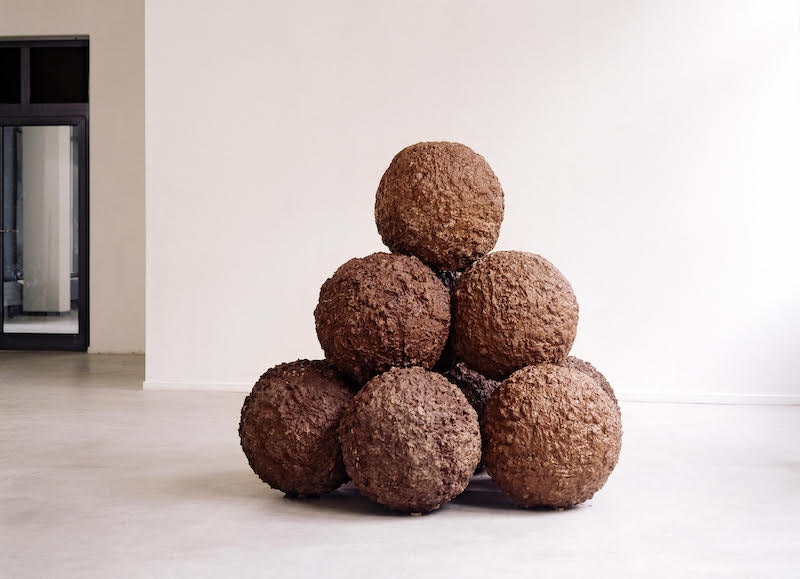
Sonja Alhäuser: ‘Pyramide’, 2000–2017, chocolate, cacaobutter, 140 x140 x160 cm // Courtesy of VG Bild-Kunst, Bonn
PR: I was recently talking to another artist, Monika Grabuschnigg, who told me she was initially battling with her work because she wanted to use a lot of pink and heart motifs and didn’t feel able because of her gender. Did you ever feel hampered or at least worried by creating the work you do as a female?
SA: I was not so worried about my chosen material nor the pastel colours I use and I still don’t really, to be honest. When I use materials such as chocolate and marzipan or choose a pastel colour palette, as an artist, I always choose to work with the symbolic and gender-specific charges of that specific material and those colours. I try to work out how I can mutate these projections and that is what I find exciting.
I know that my works are obviously “feminine”, but the obviousness of gender should never prevent an artistic work from functioning formally and having certain othering qualities. Rather, it is about not relying on the selection of gender issues and neglecting formal aspects.
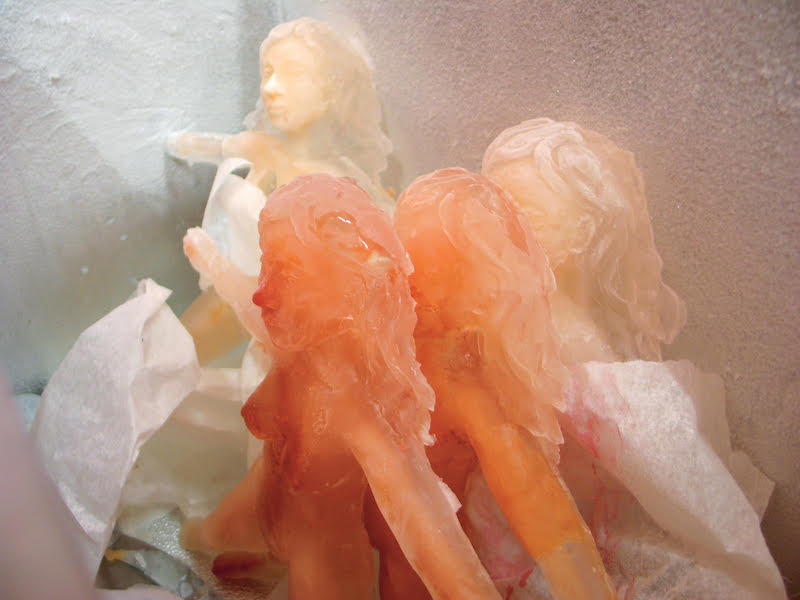
Sonja Alhäuser: ‘Bloody Mary’, detail, 2005–2018, installation and action, water ice, food coloring, champagne, freezer, stainless steel frame with integrated drawing and acrylic glass basin // Photo by Dirk Dobke, Hamburg // Courtesy of VG Bild-Kunst, Bonn
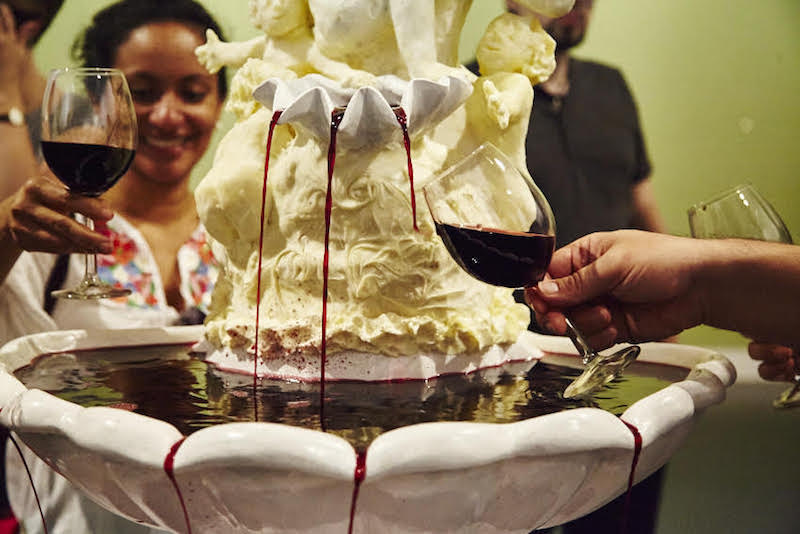
Sonja Alhäuser: ‘Rotweinbrunnen’, 2017, plastic, plaster, margarine, circulation pump, red wine, 175 x 90 x 80 cm // Photo by Inga Barnick, Braunschweig // Courtesy of VG Bild-Kunst, Bonn
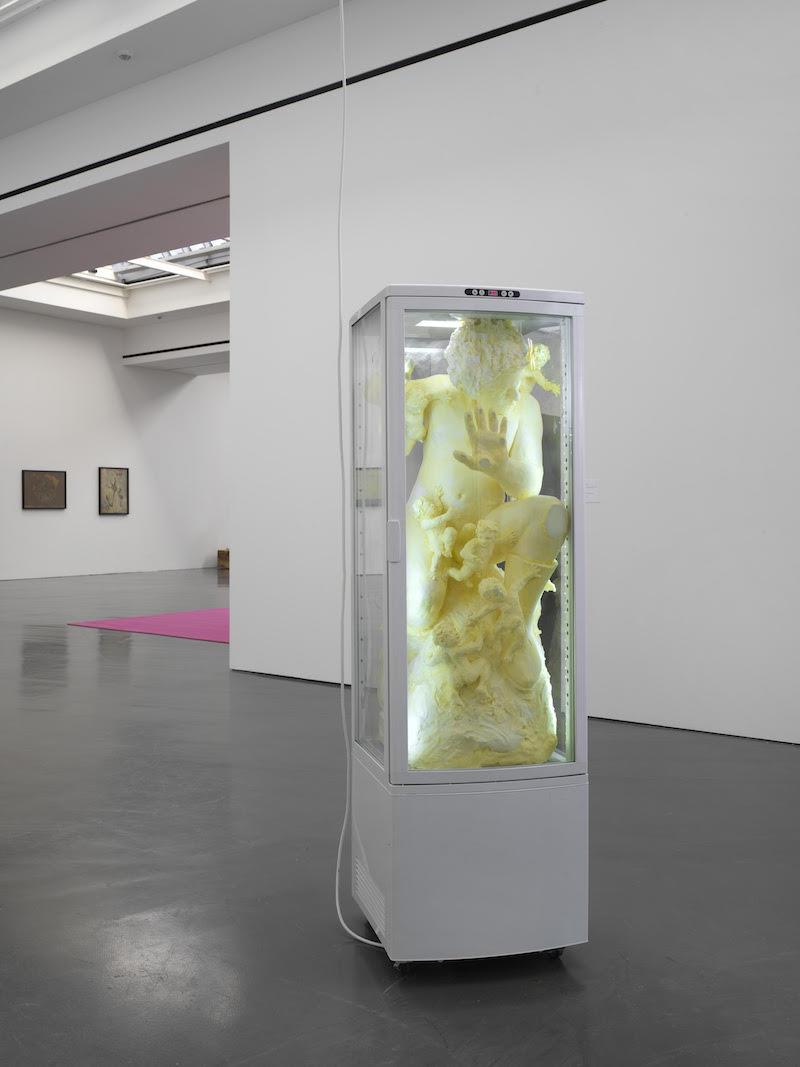
Sonja Alhäuser: ‘Das Willkommen’, 2010, margarine, illuminated refrigerated display case, 52 x 49 x 169 cm // Photo by Achim Kukulies // Courtesy of VG Bild-Kunst, Bonn
























